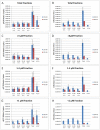High humidity leads to loss of infectious influenza virus from simulated coughs
- PMID: 23460865
- PMCID: PMC3583861
- DOI: 10.1371/journal.pone.0057485
High humidity leads to loss of infectious influenza virus from simulated coughs
Abstract
Background: The role of relative humidity in the aerosol transmission of influenza was examined in a simulated examination room containing coughing and breathing manikins.
Methods: Nebulized influenza was coughed into the examination room and Bioaerosol samplers collected size-fractionated aerosols (<1 µM, 1-4 µM, and >4 µM aerodynamic diameters) adjacent to the breathing manikin's mouth and also at other locations within the room. At constant temperature, the RH was varied from 7-73% and infectivity was assessed by the viral plaque assay.
Results: Total virus collected for 60 minutes retained 70.6-77.3% infectivity at relative humidity ≤23% but only 14.6-22.2% at relative humidity ≥43%. Analysis of the individual aerosol fractions showed a similar loss in infectivity among the fractions. Time interval analysis showed that most of the loss in infectivity within each aerosol fraction occurred 0-15 minutes after coughing. Thereafter, losses in infectivity continued up to 5 hours after coughing, however, the rate of decline at 45% relative humidity was not statistically different than that at 20% regardless of the aerosol fraction analyzed.
Conclusion: At low relative humidity, influenza retains maximal infectivity and inactivation of the virus at higher relative humidity occurs rapidly after coughing. Although virus carried on aerosol particles <4 µM have the potential for remaining suspended in air currents longer and traveling further distances than those on larger particles, their rapid inactivation at high humidity tempers this concern. Maintaining indoor relative humidity >40% will significantly reduce the infectivity of aerosolized virus.
Conflict of interest statement
Figures




Similar articles
-
Review of factors affecting virus inactivation in aerosols and droplets.J R Soc Interface. 2024 Jun;21(215):18. doi: 10.1098/rsif.2024.0018. Epub 2024 Jun 26. J R Soc Interface. 2024. PMID: 38920060 Free PMC article. Review.
-
Detection of infectious influenza virus in cough aerosols generated in a simulated patient examination room.Clin Infect Dis. 2012 Jun;54(11):1569-77. doi: 10.1093/cid/cis237. Epub 2012 Mar 29. Clin Infect Dis. 2012. PMID: 22460981 Free PMC article.
-
Measurements of airborne influenza virus in aerosol particles from human coughs.PLoS One. 2010 Nov 30;5(11):e15100. doi: 10.1371/journal.pone.0015100. PLoS One. 2010. PMID: 21152051 Free PMC article.
-
Viable influenza A virus in airborne particles from human coughs.J Occup Environ Hyg. 2015;12(2):107-13. doi: 10.1080/15459624.2014.973113. J Occup Environ Hyg. 2015. PMID: 25523206 Free PMC article.
-
Systematic review of the effects of environmental factors on virus inactivation: implications for coronavirus disease 2019.Int J Environ Sci Technol (Tehran). 2021;18(9):2865-2878. doi: 10.1007/s13762-021-03495-9. Epub 2021 Jul 17. Int J Environ Sci Technol (Tehran). 2021. PMID: 34306118 Free PMC article. Review.
Cited by
-
Dependence of aerosol-borne influenza A virus infectivity on relative humidity and aerosol composition.Front Microbiol. 2024 Oct 16;15:1484992. doi: 10.3389/fmicb.2024.1484992. eCollection 2024. Front Microbiol. 2024. PMID: 39479211 Free PMC article.
-
Impact of organic compounds on the stability of influenza A virus in deposited 1-μL droplets.mSphere. 2024 Sep 25;9(9):e0041424. doi: 10.1128/msphere.00414-24. Epub 2024 Aug 22. mSphere. 2024. PMID: 39171937 Free PMC article.
-
Laboratory studies on the infectivity of human respiratory viruses: Experimental conditions, detections, and resistance to the atmospheric environment.Fundam Res. 2024 Feb 21;4(3):471-483. doi: 10.1016/j.fmre.2023.12.017. eCollection 2024 May. Fundam Res. 2024. PMID: 38933192 Free PMC article. Review.
-
Review of factors affecting virus inactivation in aerosols and droplets.J R Soc Interface. 2024 Jun;21(215):18. doi: 10.1098/rsif.2024.0018. Epub 2024 Jun 26. J R Soc Interface. 2024. PMID: 38920060 Free PMC article. Review.
-
Evaluating airflow dynamics in common vertical circulation spaces of a multi-floor apartment building for mitigating airborne infection risks: A CFD modeling study.Heliyon. 2024 Feb 23;10(5):e26596. doi: 10.1016/j.heliyon.2024.e26596. eCollection 2024 Mar 15. Heliyon. 2024. PMID: 38439893 Free PMC article.
References
-
- Hemmes JH, Winkler KC, Kool SM (1960) Virus survival as a seasonal factor in influenza and poliomyelitis. Nature 188: 430–431. - PubMed
Publication types
MeSH terms
Substances
Grants and funding
LinkOut - more resources
Full Text Sources
Other Literature Sources
Medical


